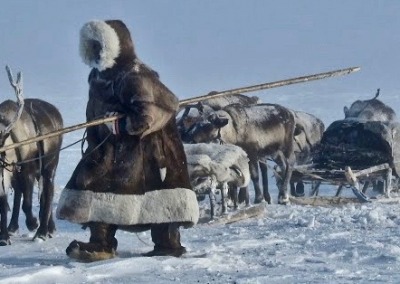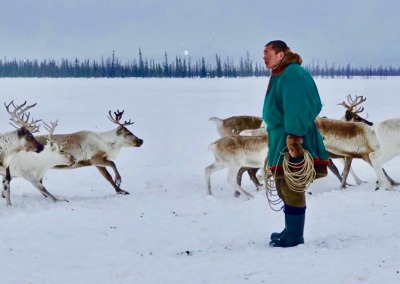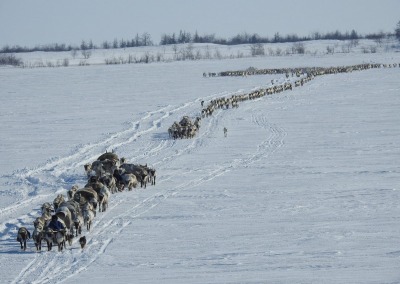Autumn
September: The Nenets call September vyba iry – “the leaf-falling month”. The tundra is by now mostly a dark yellow or brown. The first snows often occur in the first half of September, although the snow rarely settles so early. The Nenets are at this time migrating south at a rate of 2 – 4 times a week.
September is the time when most camps castrate their male reindeer. This is done in order to leave around fifteen female deer for every non-castrated male. This is done for a number of reasons. Mainly it is so that the males do not get distracted by females when migrating or pulling sledges, which could slow things down or even become dangerous. It is also because if there are too many males, they can get quite sexually aggressive with the females, harming or even killing them. Castration is done differently at different camps. Most people either use a knife or just beat them with a stick. Some people, more traditionally, use their teeth to bite through the seminal ducts. This is said to leave less of a wound.
In late September the rut begins and continues into October. This time is known as khora iry – “the month of the reindeer bull.” This can get quite chaotic and hard to control. In addition snow is by now causing the tundra to become quite swampy and river levels to rise, making them much harder to cross. The contents of the sledges, including clothes and bedding, can get wet during river crossings, leading to quite miserable conditions afterwards.
All this combined makes September and October very tough months.
The first half of September can be a great time to visit the Yar-Sale Nenets. It is still not too cold but the mosquitoes and other flying nuisances of July and August are no longer a problem. Migrations are going ahead 2 – 4 times a week and all herding work is still done on reindeer sledges. This means the whole herd is driven up to the chums every day for the herders to lasso new sledge reindeer, a truly spectacular event.
October: The Yar-Sale herders cross the Yuribey River on their way south. In some years there is already complete snow cover in October. In other years there is just a scattering of frost. Rivers are not yet frozen.
Some camps start doing their annual slaughter at this time. For this they need to be camped near a permanent corral site, into which they will drive their herd every day for several days in a row to conduct the slaughter. Note that these commercial slaughters are not done in the traditional way (strangling) but are done with a knife.
The second half of September and the whole of October are not great months to visit the Yar-Sale Nenets. Conditions for them become very tough so they may have less time to devote to guests. They are also right in the centre of the Yamal Peninsula at this time, crossing it from northwest to southeast. This,
combined with higher levels in the Yamal Peninsula’s 3,000 rivers caused by the first snows, makes them almost impossible to access without a helicopter. At this time we usually run tours to other nomad camps around Yorkuta trading post on the western coast of the Yamal Peninsula.
November: The second half of November is, in our opinion, one of the best times to visit. It is getting cold and, as the Nenets are still camped on the treeless Yamal Peninsula, it can be very windy. This means more people are wearing their full range of traditional clothing, including gus jackets and women’s hats. Later on in the warmer, less windy forest tundra from February to March you see fewer people wearing these items. In the forest tundra everyone is dressed traditionally in malitsas, yagushki and kisy boots but due to the better weather they do not need to wear the extras (gus and women’s hats) mentioned above and explained on our Traditional clothing page.
Also in the second half of November all rivers are frozen enough to drive on in all-terrain vehicles and snowmobiles. This means that every single nomad camp on the Yamal Peninsula is accessible to us. We will have a much bigger selection of camps to choose from when deciding where to send our guests. This in turn means that we have a better chance of finding one that suits the individual goals and requirements of our guests. The camps that are most interesting to most people (those with 3,000 to 11,000 reindeer and who migrate 2 – 4 times a week) are accessible from now until mid-May.
The tundra itself can also be very beautiful at this time. The wind is sculpting the snow into beautiful structures such as sastrugi. The snow is rock-solid and smooth, meaning that when the sun sets, the whole tundra is lit up and reflects the colour of the sunset: sometimes gold, sometimes purple, sometimes red and sometimes orange. (In spring, when the snow is softer and gets more churned up, you do not see this effect.) During the short winter day, there are often lots of snow crystals being blown around in the air. When the sun shines these start glittering, turning the air itself into a sparkling mass of crystals.
The Nenets call November ngiudia pevdei – “the little darkness”. Daylight hours are getting rapidly shorter. There are nine hours at the beginning of the month but only six by the end. Blizzards become more common. We have seen temperatures as high as +5°C at the beginning of November and as low as -60°C at the end of the month. Both, however, were so unusual that they were considered almost catastrophic for the reindeer. Somewhere in the middle is, of course, much more common.
More camps do their annual slaughter in November. If you can make it before the slaughter, herds will be bigger and more impressive. For example the biggest camp we work with has 11,000 reindeer before the slaughter but only about 7,000 afterwards.
September: The Nenets call September vyba iry – “the leaf-falling month”. The tundra is by now mostly a dark yellow or brown. The first snows often occur in the first half of September, although the snow rarely settles so early. The Nenets are at this time migrating south at a rate of 2 – 4 times a week.
September is the time when most camps castrate their male reindeer. This is done in order to leave around fifteen female deer for every non-castrated male. This is done for a number of reasons. Mainly it is so that the males do not get distracted by females when migrating or pulling sledges, which could slow things down or even become dangerous. It is also because if there are too many males, they can get quite sexually aggressive with the females, harming or even killing them. Castration is done differently at different camps. Most people either use a knife or just beat them with a stick. Some people, more traditionally, use their teeth to bite through the seminal ducts. This is said to leave less of a wound.
In late September the rut begins and continues into October. This time is known as khora iry – “the month of the reindeer bull.” This can get quite chaotic and hard to control. In addition snow is by now causing the tundra to become quite swampy and river levels to rise, making them much harder to cross. The contents of the sledges, including clothes and bedding, can get wet during river crossings, leading to quite miserable conditions afterwards.
All this combined makes September and October very tough months.
The first half of September can be a great time to visit the Yar-Sale Nenets. It is still not too cold but the mosquitoes and other flying nuisances of July and August are no longer a problem. Migrations are going ahead 2 – 4 times a week and all herding work is still done on reindeer sledges. This means the whole herd is driven up to the chums every day for the herders to lasso new sledge reindeer, a truly spectacular event.
October: The Yar-Sale herders cross the Yuribey River on their way south. In some years there is already complete snow cover in October. In other years there is just a scattering of frost. Rivers are not yet frozen.
Some camps start doing their annual slaughter at this time. For this they need to be camped near a permanent corral site, into which they will drive their herd every day for several days in a row to conduct the slaughter. Note that these commercial slaughters are not done in the traditional way (strangling) but are done with a knife.
The second half of September and the whole of October are not great months to visit the Yar-Sale Nenets. Conditions for them become very tough so they may have less time to devote to guests. They are also right in the centre of the Yamal Peninsula at this time, crossing it from north west to south east. This, combined with higher levels in the Yamal Peninsula’s 3,000 rivers caused by the first snows, makes them almost impossible to access without a helicopter. At this time we usually run tours to other nomad camps around Yorkuta trading post on the western coast of the Yamal Peninsula.
November:
The second half of November is, in our opinion, one of the best times to visit. It is getting cold and, as the Nenets are still camped on the treeless Yamal Peninsula, it can be very windy. This means more people are wearing their full range of traditional clothing, including gus jackets and women’s hats. Later on in the warmer, less windy forest tundra from February to March you see fewer people wearing these items. In the forest tundra everyone is dressed traditionally in malitsas, yagushki and kisy boots but due to the better weather they do not need to wear the extras (gus and women’s hats) mentioned above and explained on our Traditional clothing page.
Also in the second half of November all rivers are frozen enough to drive on in all-terrain vehicles and snowmobiles. This means that every single nomad camp on the Yamal Peninsula is accessible to us. We will have a much bigger selection of camps to choose from when deciding where to send our guests. This in turn means that we have a better chance of finding one that suits the individual goals and requirements of our guests. The camps that are most interesting to most people (those with 3,000 to 11,000 reindeer and who migrate 2 – 4 times a week) are accessible from now until mid-May.
The tundra itself can also be very beautiful at this time. The wind is sculpting the snow into beautiful structures such as sastrugi. The snow is rock-solid and smooth, meaning that when the sun sets, the whole tundra is lit up and reflects the colour of the sunset: sometimes gold, sometimes purple, sometimes red and sometimes orange. (In spring, when the snow is softer and gets more churned up, you do not see this effect.) During the short winter day, there are often lots of snow crystals being blown around in the air. When the sun shines these start glittering, turning the air itself into a sparkling mass of crystals.
The Nenets call November ngiudia pevdei – “the little darkness”. Daylight hours are getting rapidly shorter. There are nine hours at the beginning of the month but only six by the end. Blizzards become more common. We have seen temperatures as high as +5°C at the beginning of November and as low as -60°C at the end of the month. Both, however, were so unusual that they were considered almost catastrophic for the reindeer. Somewhere in the middle is, of course, much more common.
More camps do their annual slaughter in November. If you can make it before the slaughter, herds will be bigger and more impressive. For example the biggest camp we work with has 11,000 reindeer before the slaughter but only about 7,000 afterwards.



